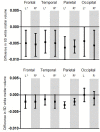Hearing Impairment Is Associated with Smaller Brain Volume in Aging
- PMID: 28163683
- PMCID: PMC5247429
- DOI: 10.3389/fnagi.2017.00002
Hearing Impairment Is Associated with Smaller Brain Volume in Aging
Erratum in
-
Corrigendum: Hearing Impairment Is Associated with Smaller Brain Volume in Aging.Front Aging Neurosci. 2017 May 8;9:131. doi: 10.3389/fnagi.2017.00131. eCollection 2017. Front Aging Neurosci. 2017. PMID: 28491034 Free PMC article.
Abstract
Although recent studies show that age-related hearing impairment is associated with cerebral changes, data from a population perspective are still lacking. Therefore, we studied the relation between hearing impairment and brain volume in a large elderly cohort. From the population-based Rotterdam Study, 2,908 participants (mean age 65 years, 56% female) underwent a pure-tone audiogram to quantify hearing impairment. By performing MR imaging of the brain we quantified global and regional brain tissue volumes (total brain volume, gray matter volume, white matter (WM) volume, and lobe-specific volumes). We used multiple linear regression models, adjusting for age, sex, head size, time between hearing test and MR imaging, and relevant cognitive and cardiovascular covariates. Furthermore, we performed voxel-based morphometry to explore sub-regional differences. We found that a higher pure-tone threshold was associated with a smaller total brain volume [difference in standardized brain volume per decibel increase in hearing threshold in the age-sex adjusted model: -0.003 (95% confidence interval -0.004; -0.001)]. Specifically, WM volume was associated. Both associations were more pronounced in the lower frequencies. All associations were consistently present in all brain lobes in the lower frequencies and in most lobes in the higher frequencies, and were independent of cognitive function and cardiovascular risk factors. In voxel-based analyses we found associations of hearing impairment with smaller white volumes and some smaller and larger gray volumes, yet these were statistically non-significant. Our findings demonstrate that hearing impairment in elderly is related to smaller total brain volume, independent of cognition and cardiovascular risk factors. This mainly seems to be driven by smaller WM volume, throughout the brain.
Keywords: age-related hearing impairment; brain MRI; pure-tone audiogram; voxel-based analysis; white matter.
Figures




Similar articles
-
Association of white matter hyperintensities and gray matter volume with cognition in older individuals without cognitive impairment.Brain Struct Funct. 2016 May;221(4):2135-46. doi: 10.1007/s00429-015-1034-7. Epub 2015 Apr 2. Brain Struct Funct. 2016. PMID: 25833685 Free PMC article.
-
Tinnitus and Its Central Correlates: A Neuroimaging Study in a Large Aging Population.Ear Hear. 2021 Sep/Oct;42(5):1428-1435. doi: 10.1097/AUD.0000000000001042. Ear Hear. 2021. PMID: 33974782
-
The Effect of Hearing Aid Use on the Association Between Hearing Loss and Brain Structure in Older Adults.Ear Hear. 2022 May/Jun;43(3):933-940. doi: 10.1097/AUD.0000000000001148. Ear Hear. 2022. PMID: 34711744
-
Global and regional associations of smaller cerebral gray and white matter volumes with gait in older people.PLoS One. 2014 Jan 8;9(1):e84909. doi: 10.1371/journal.pone.0084909. eCollection 2014. PLoS One. 2014. PMID: 24416309 Free PMC article.
-
Association of hearing impairment with brain volume changes in older adults.Neuroimage. 2014 Apr 15;90:84-92. doi: 10.1016/j.neuroimage.2013.12.059. Epub 2014 Jan 9. Neuroimage. 2014. PMID: 24412398 Free PMC article.
Cited by
-
Hippocampal atrophy is associated with hearing loss in cognitively normal adults.Front Neurosci. 2023 Oct 24;17:1276883. doi: 10.3389/fnins.2023.1276883. eCollection 2023. Front Neurosci. 2023. PMID: 37942139 Free PMC article.
-
Translational and interdisciplinary insights into presbyacusis: A multidimensional disease.Hear Res. 2021 Mar 15;402:108109. doi: 10.1016/j.heares.2020.108109. Epub 2020 Oct 31. Hear Res. 2021. PMID: 33189490 Free PMC article. Review.
-
Volumetric Analysis of Hearing-Related Structures of Brain in Children with GJB2-Related Congenital Deafness.Children (Basel). 2022 May 30;9(6):800. doi: 10.3390/children9060800. Children (Basel). 2022. PMID: 35740737 Free PMC article.
-
The Rotterdam Study: 2018 update on objectives, design and main results.Eur J Epidemiol. 2017 Sep;32(9):807-850. doi: 10.1007/s10654-017-0321-4. Epub 2017 Oct 24. Eur J Epidemiol. 2017. PMID: 29064009 Free PMC article.
-
[Central and peripheral aspects of noise-induced hearing loss].HNO. 2018 May;66(5):342-349. doi: 10.1007/s00106-017-0442-9. HNO. 2018. PMID: 29204664 Review. German.
References
-
- Bokde A. L., Teipel S. J., Schwarz R., Leinsinger G., Buerger K., Moeller T. (2005). Reliable manual segmentation of the frontal, parietal, tempora land occipital lobes on magnetic resonance images of healthy subjects. Brain Res. Brain Res. Protoc. 14 135–145. 10.1016/brainresprot.2004.10.001 - DOI - PubMed
LinkOut - more resources
Full Text Sources
Other Literature Sources

